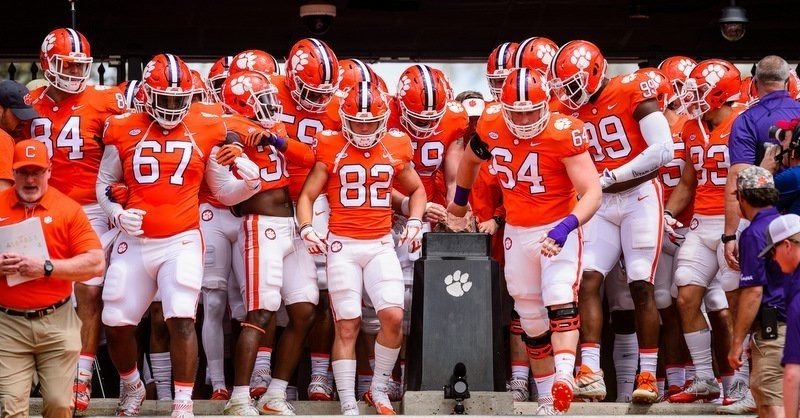
NCAA releases latest guidelines for return to football, more sports |
The NCAA released a number of guidelines
for the return for college athletics, including for testing and quarantining regarding COVID-19.
These were the key recommendations: - Daily self-health checks. - The appropriate use of face coverings and social distancing during training, competition and outside of athletics. - Testing strategies for all athletics activities, including pre-season, regular season and post-season. - Testing and results within 72 hours of competition in high contact risk sports (like football, basketball, soccer, rowing and volleyball at Clemson; baseball is tagged as "medium"). - Member schools must adhere to public health standards set by their local communities. In addition to the athletes and personnel, officials in football and basketball, due to their close contact with athletes, should also be tested weekly per the guidelines. Another officials-related suggestion is "schools should consider the use of electronic whistles in practice scenarios as a strategy to avoid the deep breath and forced burst of droplet-filled air that results from the use of a traditional whistle." Teams will have to consider how they practice and conduct meetings as well: "Schools should consider the establishment of 'functional units' as a strategy to minimize the potential spread of COVID-19. A functional unit may be composed of five to 10 individuals, all members of the same team, who consistently work out and participate in activities together. Assuming that these individuals observe appropriate sanitization, physical distancing and universal masking practices at all other times and do not otherwise place themselves in high contact risk scenarios (for example, attending off-campus social events), the individuals would only be considered high risk to one another. A similar strategy is to have one unit of a team always train against another unit of a team. For example, the first unit of the football team always training against the third unit of the football team; and the second and fourth units always training together. This means that if an individual from one of those units does become infected, the entire team may not be impacted, and contact tracing may be more manageable than it would be otherwise in the event of an infection." Among other notable guidelines and advisories to football, there's this section: "Published data confirms that the risk of death from COVID-19 increases with age and high-risk underlying medical conditions, students and student-athletes who are not in high-risk categories themselves may be unlikely to have complications from COVID-19, but they represent a significant threat to any high-risk category individuals with whom they may have unprotected contact. These risks must be considered as part of the risk/benefit ratio of resocialization of collegiate sport. Of note, sports such as football may have an overrepresentation of student-athletes (for example, football linemen) who meet the high-risk criteria as it relates to obesity. For this reason, prevention and testing strategies should recognize that some athletes may have an increased risk of adverse outcomes from COVID-19." Another is a call for face shields on helmets: "Face shields also have been developed for football helmets and are made to affix to the helmet’s rigid face mask. Like masks/cloth face covering, the shields are designed to prevent the outward projection of respiratory droplets during coughing, sneezing, heavy breathing, or grunting. It should be noted that these products are considered helmet add-ons and require confirmation from the helmet manufacturer that the helmet can retain necessary National Operating Committee on Standards for Athletic Equipment certification when the shield is added. Schools are advised to confirm with the manufacturer of their football helmets before deciding to purchase or add a face shield product." On team travel: "Public travel poses logistical challenges related to potential exposure and appropriate risk mitigation. Schools should continue to evaluate the current data regarding risks related to commercial plane and other travel, and travel protocols should be considered that include physical distancing, as possible, and universal masking for all individuals traveling with others by private car, van, chartered bus or chartered plane. Schools should also plan for proper communication of all travel rules, protocols and expectations to everyone in the travel party. When feasible, schools should aim to travel and play the same day to avoid overnight stays. For overnight stays or same-day travel, prepackaged meals or room service should be considered. If restaurant dining is the only option, consider take-out food or outdoor eating as preferable alternatives." More notes from the guidelines include: - Individuals who test positive and are symptomatic should remain in isolation until at least 72 hours have passed since recovery, which is defined as resolution of fever without the use of fever-reducing medications and improvement in any respiratory symptoms and at least 10 days have passed since symptoms first appeared. -Individuals who test positive for COVID-19 but have not developed any symptoms may discontinue isolation 10 days after the date of their first COVID-19 diagnostic test, assuming they have not subsequently developed symptoms. If symptoms do develop, this time-based strategy should not be used, and the symptom-based strategy should be used instead. -Universal masking should be observed on all sidelines, including when an athlete moves from the playing field to the sideline to confer with a coach. - Training should occur outdoors. When not feasible, indoor training with good ventilation is preferable to indoor training with poor ventilation. - Hand sanitization, cough/sneeze etiquette, physical distancing and masks/cloth face coverings are key in COVID-19 risk mitigation. - Time-based strategies for resuming activities after positive test results should follow CDC recommendations. - All individuals with high-risk exposure must be quarantined for 14 days. - All student-athletes and athletics personnel should understand that COVID-19 risk mitigation practices should be observed at all times, including non-athletic related activities.
 Upgrade Your Account
Upgrade Your Account
Unlock premium boards and exclusive features (e.g. ad-free) by upgrading your account today.
Upgrade Now




